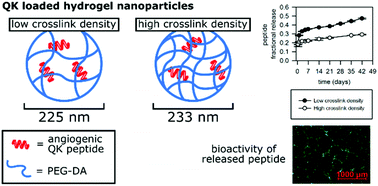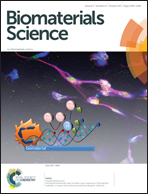Design and characterization of hydrogel nanoparticles with tunable network characteristics for sustained release of a VEGF-mimetic peptide
Abstract
Peptides that mimic the bioactivity of growth factors are rapidly emerging as therapeutics for a variety of drug delivery applications including therapeutic neovascularization. Neovascularization requires controlled and sustained delivery of proangiogenic factors to stimulate reperfusion of ischemic tissues. To this end, hydrogel nanoparticles were designed to provide sustained and tunable diffusion-based release of a pro-angiogenic peptide, QK. Inverse phase mini-emulsion polymerization (IPMP) was used to generate crosslinked poly(ethylene) glycol (PEG) hydrogel nanoparticles entrapped with the QK peptide. Peptide release kinetics were tuned through adjustments in nanoparticle crosslink density. This was achieved by altering the mole fraction of the crosslinking agent which allowed for the synthesis of low crosslink density (0.754 mmol cm−3) and high crosslink density (0.810 mmol cm−3) nanoparticles. Nanoparticle tracking analysis revealed narrow particle size distributions and similar particle sizes regardless of crosslink density (225 ± 75 nm and 233 ± 73 nm, for low and high crosslink density nanoparticles, respectively). The zeta potential was found to be −26 mV for blank nanoparticles and +4 mV in the case of QK-loaded nanoparticles. The resulting nanoparticle crosslink density impacted both peptide loading as well as release kinetics. In terms of cumulative fractional release and weight of peptide released per mass of nanoparticle, higher crosslink density nanoparticles resulted in slower peptide release kinetics. The IPMP process preserved the QK secondary structure and its bioactivity as confirmed using circular dichroism spectroscopy and a Matrigel tubulogenesis assay, respectively, with released peptide. The presented nanoparticles hold great potential for use as drug delivery carriers for stimulation of therapeutic neovascularization of ischemic tissues.



 Please wait while we load your content...
Please wait while we load your content...